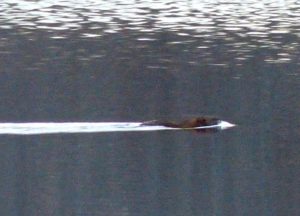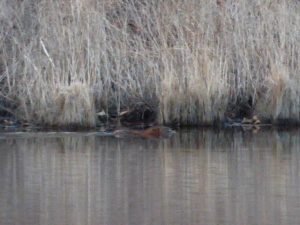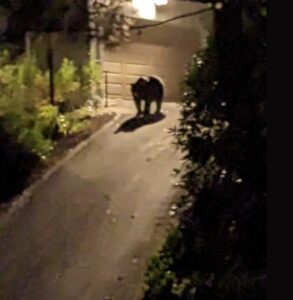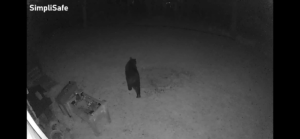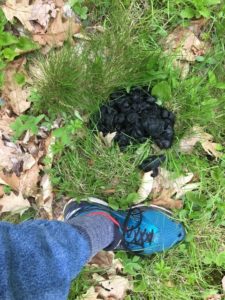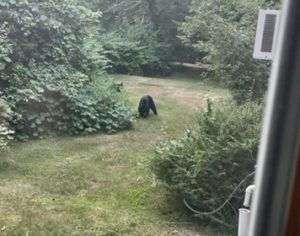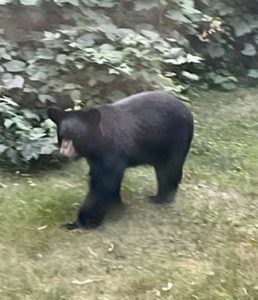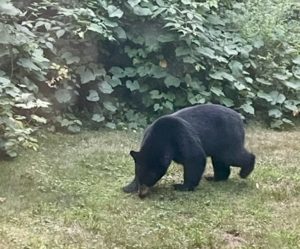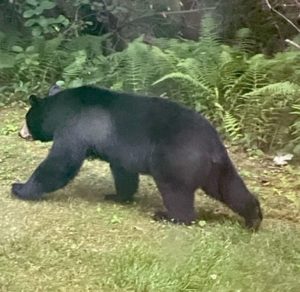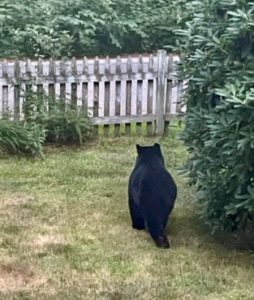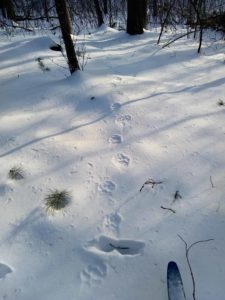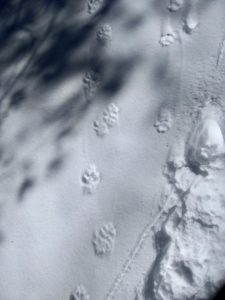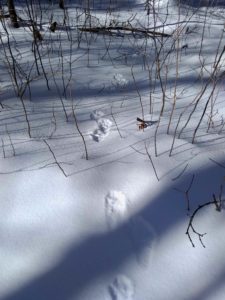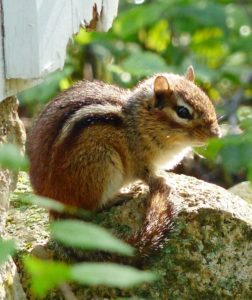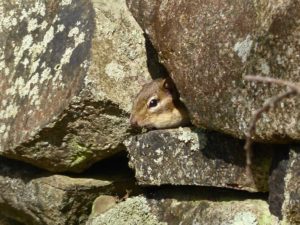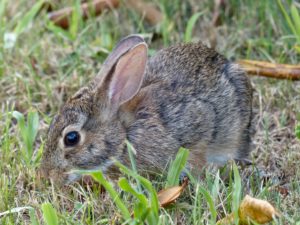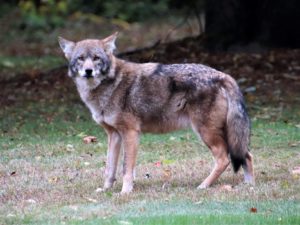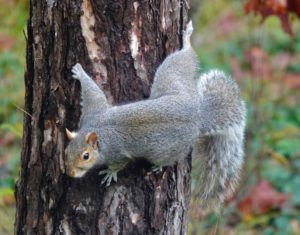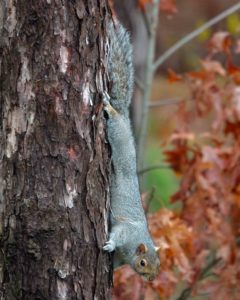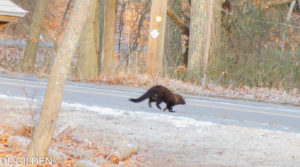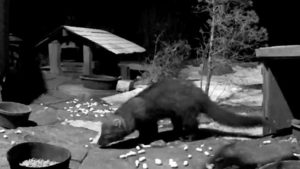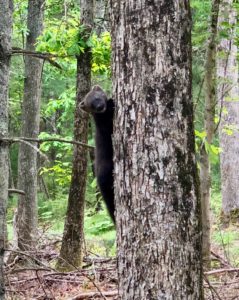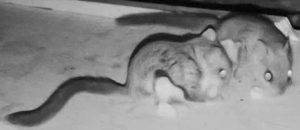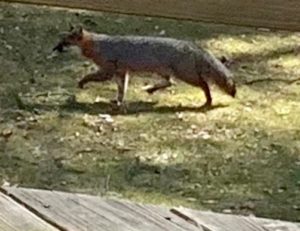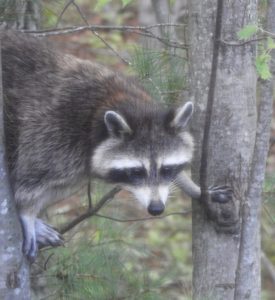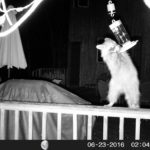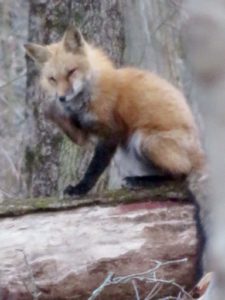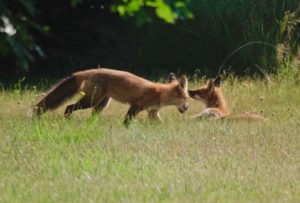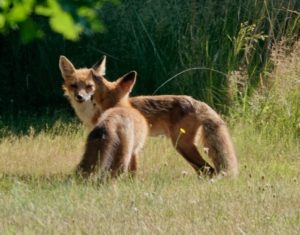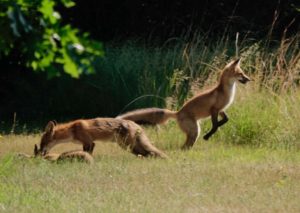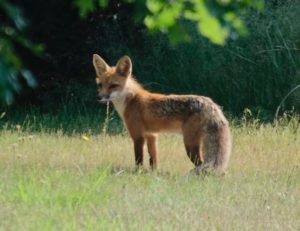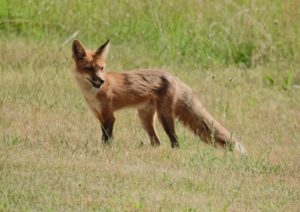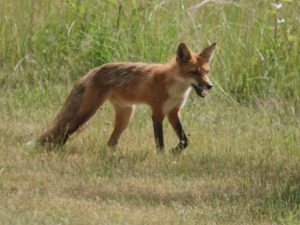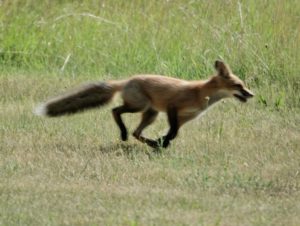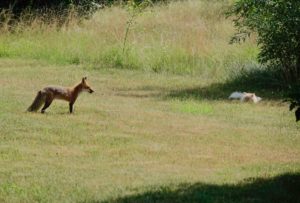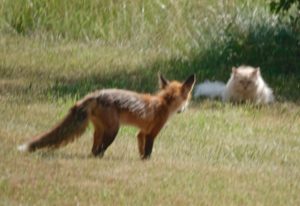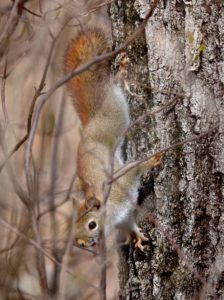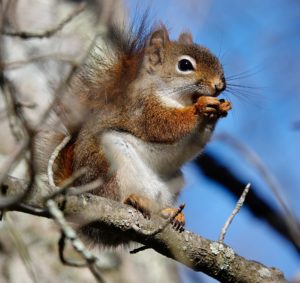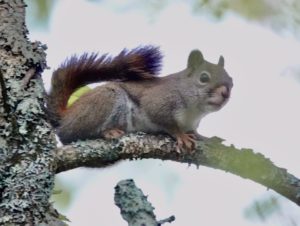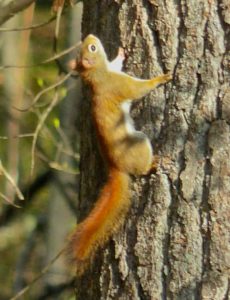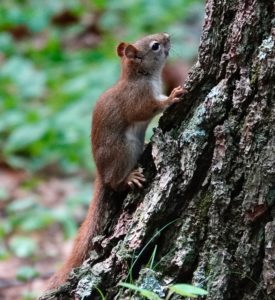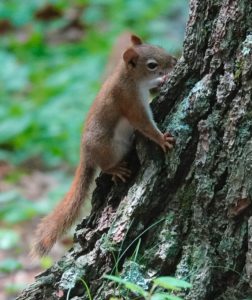Sightings – Mammal
Observer: Paul Lauenstein
Observation Date: 4/20/14
Observation Time: 7:15 p.m.
Observation Location: Gavins Pond
Common Name: Beaver
Scientific Name: Castor canadensis
Comments: Beavers are the second-largest living rodents, after capybaras, weighing up to 50 kg (110 lb). They build dams to form ponds in which they then build a lodge to protect themselves from predators.
More Information: Wikipedia
Observer: Paul Lauenstein
Observation Date: 11/12/12
Observation Time: 5:30 p.m.
Observation Location: Gavins Pond Dam
Common Name: Big Brown Bat
Scientific Name: Eptesicus fuscus
Comments: New England has little brown bats and big brown bats. Little brown bats are only found in New England in summer. Since these bats were observed in mid-November, they are presumably big brown bats. Bats fly fast, so getting these photos was not easy!
More Information: Mass Audubon
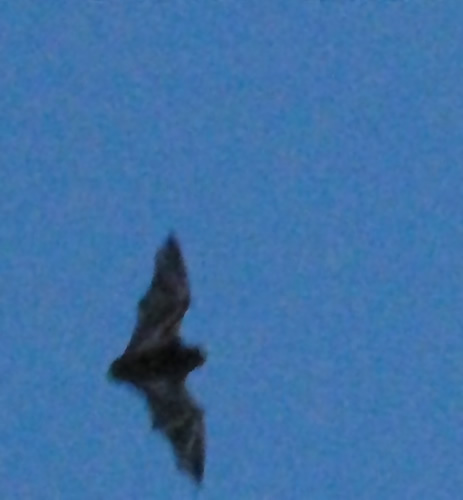
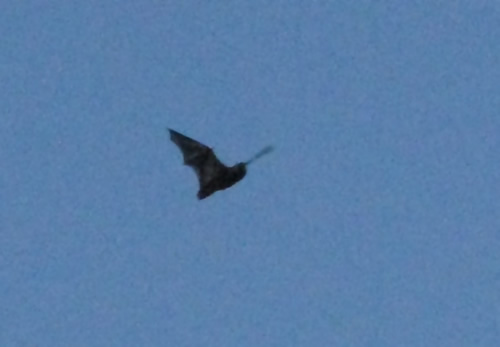
Observer: Leonid Fofanov
Observation Date: 10/3/24
Observation Time: night
Observation Location: Agawam Rd. near Chase Dr.
Common Name: American Black Bear
Scientific Name: Ursus Americanus
Comments: Multiple black bear sightings have been reported in Sharon over the past few years. It could be the same individual.
Black bears are not normally aggressive unless their cubs are threatened, but they can run considerably faster than an Olympic sprinter and are quite capable of mauling a human, so keep your distance.
More Information: Wikipedia
Observer: Emma Smith
Observation Date: 10/5/24
Observation Time: night
Observation Location: Off Wolomolopoag near Chase Dr. & E. Foxboro St.
Common Name: American Black Bear
Scientific Name: Ursus Americanus
Comments: Multiple black bear sightings have been reported in Sharon over the past few years. It could be the same individual.
Black bears are not normally aggressive unless their cubs are threatened, but they can run considerably faster than an Olympic sprinter and are quite capable of mauling a human, so keep your distance.
More Information: Wikipedia
Observer: Mark Richardson
Observation Date: 4/13/24
Observation Time: night
Observation Location: E. Foxboro St.
Common Name: American Black Bear
Scientific Name: Ursus Americanus
Comments: Sharon’s black bear was active in the E. Foxboro Street area last night, taking down our bird feeder and feeding voraciously on the seed!
Black bears are hungry when they emerge from hibernation in the early spring.
More Information: Wikipedia
Observer: Rob Brewer
Observation Date: 4/17/24
Observation Time: 11:35 pm
Observation Location: back yard on Norwood Street
Common Name: American Black Bear
Scientific Name: Ursus Americanus
Comments: Black bears are hungry when they emerge from hibernation in spring, and there is not much to eat in the natural environment. That’s why it is important to secure bird feeders and garbage cans. Interactions between humans and bears often end badly for one or the other or both.
Black bears have better eyesight and hearing than humans. Their keenest sense is their sense of smell, which is about seven times more sensitive than a domestic dog’s.
More Information: Wikipedia
Observer: Kurt Buermann
Observation Date: 5/6/23
Observation Time: nighttime
Observation Location: 45 Furnace St.
Common Name: American Black Bear
Scientific Name: Ursus Americanus
Comments: A young black bear raided Kurt’s cache of bird seed. Kurt used a camera trap to get this video of the bear wandering around his house.
More Information: Wikipedia
Observer: Richard Mandel
Observation Date: 6/24/23
Observation Time: at night
Observation Location: Mountain Street
Common Name: American Black Bear
Scientific Name: Ursus Americanus
Comments: This black bear destroyed two bird feeders at our house during the night of June 24, 2023, and devoured the contents of the feeders. In addition it left some droppings.
American black bears have better eyesight and hearing than humans. Their keenest sense is their sense of smell, which is about seven times more sensitive than a domestic dog’s.
American black bears tend to be territorial and non-gregarious in nature. Bear sightings in Sharon are rare. This young bear might have been passing through Sharon seeking a territory of its own.
More Information: Wikipedia
Black Bear video June 24, 2023
bear droppings:
Observer: Steven Kraus
Observation Date: 6/5/24
Observation Time: 4:00 a.m.
Observation Location: Arboro Dr.
Common Name: American Black Bear
Scientific Name: Ursus Americanus
Comments: Multiple black bear sightings have been reported in Sharon over the past few years. It could be the same individual.
Black bears are not normally aggressive unless their cubs are threatened, but they can run considerably faster than an Olympic sprinter and are quite capable of mauling a human, so keep your distance.
More Information: Wikipedia
Observer: Emily Smith-Lee
Observation Date: 7/30/22
Observation Time: 3:00 pm
Observation Location: 33 Moose Hill Parkway
Common Name: American Black Bear
Scientific Name: Ursus Americanus
Comments: He came out of the woods behind our house (town owned conservation land between Moose Hill Parkway and Upland Road) and walked across our back yard before going back into the woods where our yard meets a little creek.
According to Wikipedia, “In the northeastern part of the range (the United States and Canada), prime habitat consists of a forest canopy of hardwoods such as beech, maple, birch and coniferous species. Corn crops and oak-hickory mast are also common sources of food in some sections of the Northeast; small, thick swampy areas provide excellent refuge cover largely in stands of white cedar.” Sharon’s 250-acre cedar swamp fits this description.
American black bears have better eyesight and hearing than humans. Their keenest sense is their sense of smell, which is about seven times more sensitive than a domestic dog’s.
American black bears tend to be territorial and non-gregarious in nature. Bear sightings in Sharon are extremely rare. This bear might have been passing through Sharon seeking a territory of its own.
More Information: Wikipedia
Observer: Marla Lonergan
Observation Date: 6/11/14
Observation Time: 6:00 p.m.
Observation Location: 5 Tisdale Road
Common Name: Bobcat
Scientific Name: Lynx rufus
Comments: Second bobcat sighting in Sharon in less than a week. See the NECN
report.
More Information: Wikipedia
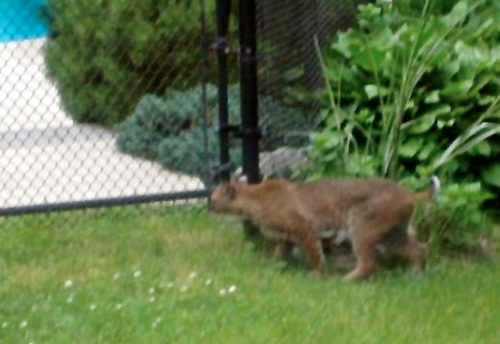
Observer: Suzy Levenson
Observation Date: 6/7/14
Observation Time: 8:15 a.m.
Observation Location: 155 Billings St
Common Name: Bobcat
Scientific Name: Lynx rufus
Comments: The bobcat was calmly sitting in my backyard looking at my housecat who was sitting in a window. There were three snapping turtles in the backyard at the same time. Then the bobcat quietly walked away into the woods.
More Information: Wikipedia

Observer: Richard Kramer
Observation Date: 2/26/22
Observation Time: 3:00 pm
Observation Location: Moose Hill Audubon WIldlife Sanctuary
Common Name: Bobcat
Scientific Name: Lynx rufus
Comments: Here’s a link to compare cougar, coyote and bobcat tracks: https://www.michigan.gov/dnr/0,4570,7-350-79135_79218_79619_84911-146656–,00.html
More Information: Wikipedia
Observer: Kirk Thomas
Observation Date: 3/3/13
Observation Time: 6:20 a.m.
Observation Location: Griffin Land
Common Name: Coyote
Scientific Name: Canis latrans
Comments: The eastern coyote (Canis latrans var.) is a wild North American canine of both coyote and wolf origins. The hybridization likely first occurred in the Great Lakes region, as western coyotes moved east. It was first noticed during the early 1930s to the late 1940s, and likely originated in the aftermath of the extirpation of the gray wolf in southeastern Ontario, Labrador and Quebec, thus allowing coyotes to colonize the former wolf ranges and mix with the remnant wolf populations. This hybrid is smaller than the eastern wolf and holds smaller territories, but is larger and holds more extensive home ranges than the typical western coyote.
More Information: Nature Works and Wikipedia
Observer: Brittaney Dunham
Observation Date: 5/1/14
Observation Time: 11:00 a.m.
Observation Location: 16 High Plain St., Sharon
Common Name: Coyote
Scientific Name: Canis latrans
Comments: This bold coyote comes into our back yard pretty regularly. As a result, our dog yard has an 8-foot fence.
More Information: Nature Works and Wikipedia

Observer: Alison Siegel
Observation Date: 5/20/09
Observation Time: 7:05 a.m.
Observation Location: Lakeview Street
Common Name: Coyote
Scientific Name: Canis latrans
Comments: At 7 AM on the mornings of 5/20 and 5/21 a single coyote was observed walking in our backyard.
More Information: Nature Works
Observer: Paul Lauenstein
Observation Date: 11/26/08
Observation Time: 2:00 p.m.
Observation Location: Bluebird house in field near Gavins Pond Road
Common Name: Deer Mouse
Scientific Name: Peromyscus maniculatus
Comments: Deer mice sometimes take up residence in bird houses. They can live up to five years in captivity but probably only live about a year in the wild. This shorter natural life span is primarily due to the very large number of predators that take and consume deer mice. These predators include foxes, coyotes, snakes, owls, hawks, and many other species of birds. In the absence of these predators, deer mice populations can become explosively large leading to serious environmental damage and degradation.
More Information: Animal Diversity Web
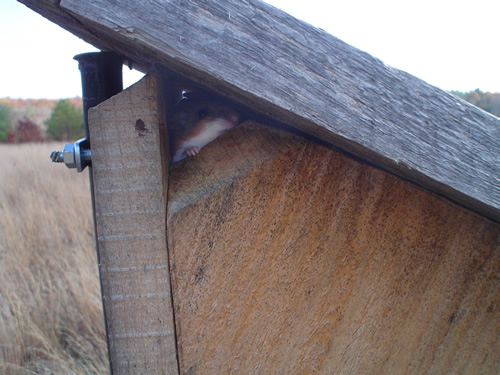
Observer: Paul Lauenstein
Observation Date: 5/11/25
Observation Time: 9:55 a.m.
Observation Location: Moose Hill Audubon Wildlife Sanctuary
Common Name: Eastern chipmunk
Scientific Name: Tamias striatus
Comments: The common name originally may have been spelled “chitmunk,” from the native Odawa (Ottawa) word jidmoonh, meaning “red squirrel” (cf. Ojibwe, ajidamoo). The earliest form cited in the Oxford English Dictionary (from 1842) is “chipmonk,” however, “chipmunk” appears in several books from the 1820s and 1830s. Other early forms include “chipmuck” and “chipminck,” and in the 1830s they were also referred to as “chip squirrels;” probably in reference to the sound they make. In the mid-1800s, John James Audubon and his sons included a lithograph of the chipmunk in their Viviparous Quadrupeds of North America, calling it the “chipping squirrel [or] hackee.” Chipmunks have also been referred to as “striped squirrels,” “timber tigers,” and “ground squirrels” (although the name “ground squirrel” usually refers to other squirrels, such as those of the genus Spermophilus). – Wikipedia
More Information: Animal Diversity Web: Eastern Chipmunk
Observer: Paul Lauenstein
Observation Date: 5/14/16
Observation Time: 8:45 a.m.
Observation Location: Moose Hill Audubon Wildlife Sanctuary
Common Name: Eastern chipmunk
Scientific Name: Tamias striatus
Comments: The common name originally may have been spelled “chitmunk,” from the native Odawa (Ottawa) word jidmoonh, meaning “red squirrel” (cf. Ojibwe, ajidamoo). The earliest form cited in the Oxford English Dictionary (from 1842) is “chipmonk,” however, “chipmunk” appears in several books from the 1820s and 1830s. Other early forms include “chipmuck” and “chipminck,” and in the 1830s they were also referred to as “chip squirrels;” probably in reference to the sound they make. In the mid-1800s, John James Audubon and his sons included a lithograph of the chipmunk in their Viviparous Quadrupeds of North America, calling it the “chipping squirrel [or] hackee.” Chipmunks have also been referred to as “striped squirrels,” “timber tigers,” and “ground squirrels” (although the name “ground squirrel” usually refers to other squirrels, such as those of the genus Spermophilus). – Wikipedia
More Information: Animal Diversity Web: Eastern Chipmunk
Observer: Paul Lauenstein
Observation Date: 5/26/10
Observation Time: 5:00 p.m.
Observation Location: Gavins Pond
Common Name: Eastern Chipmunk
Scientific Name: Tamias striatus
More Information: Animal Diversity Web: Eastern Chipmunk
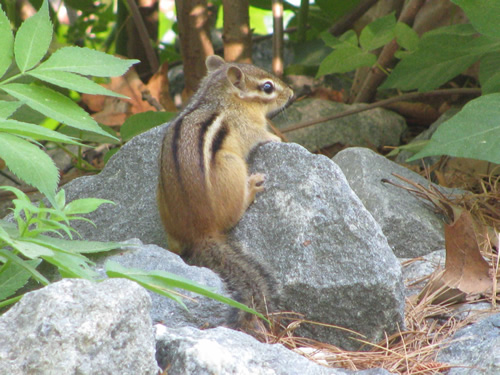
Observer: Paul Lauenstein
Observation Date: 5/8/19
Observation Time: 8:50 a.m.
Observation Location: Moose Hill Audubon Wildlife Sanctuary
Common Name: Eastern Chipmunk
Scientific Name: Tamias striatus
Comments: This chipmunk was using gaps in a stone wall to hide from predators such as hawks. It would not come out until I moved away.
More Information: Wikipedia
Observer: Peter Higgins
Observation Date: 6/8/08
Observation Time: 6:15 a.m.
Observation Location: Moose Hill Farm
Common Name: Eastern Chipmunk
Scientific Name: Tamias striatus
More Information: Animal Diversity Web: Eastern Chipmunk

Observer: Josh Simons
Observation Date: 7/17/11
Observation Time: 4:00 p.m.
Observation Location: Moose Hill area
Common Name: Eastern chipmunk
Scientific Name: Tamias striatus
More Information: Animal Diversity Web: Eastern Chipmunk
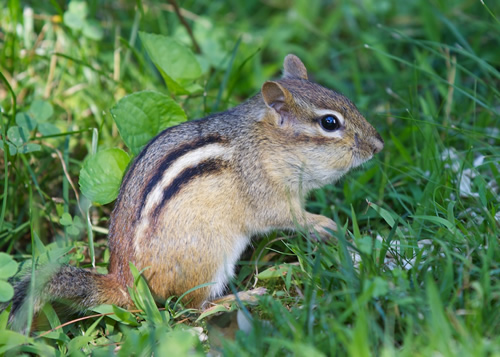
Observer: Paul Lauenstein
Observation Date: 5/31/20
Observation Time: 5:00 p.m.
Observation Location: Moose Hill Farm (TTOR)
Common Name: Eastern cottontail rabbit
Scientific Name: Sylvilagus floridanus
Comments: The Eastern cottontail is an introduced species that is now common in Sharon. Much rarer is the native New England Cottontail, which is smaller and has shorter ears and a black spot on its forehead. If is very hard to tell these two species apart without DNA testing.
More Information: NewEnglandCottontail.org
Observer: Paul Lauenstein
Observation Date: 7/27/13
Observation Time: 1:50 p.m.
Observation Location: Sharon train station
Common Name: Eastern Cottontail rabbit
Scientific Name: Sylvilagus floridanus
Comments: The Eastern Cottontail is an introduced species that is now common in Sharon. Much rarer is the native New England Cottontail, which is smaller and has shorter ears and a black spot on its forehead. If is very hard to tell these two species apart without DNA testing.
More Information: NewEnglandCottontail.org
Observer: Josh Simons
Observation Date: 1/24/2016
Observation Time: 4:30 p.m.
Observation Location: Moose Hill Parkway
Common Name: Eastern Coyote
Scientific Name: Canis latrans
Comments: The eastern coyote is part coyote, part wolf, and part domestic dog. They howl like wolves and yip like coyotes and can hunt in both open field areas and forests.
More Information: Wikipedia
Observer: John Davis
Observation Date: 10/17/19
Observation Time: 3:00 p.m.
Observation Location: 76 Edge Hill Rd.
Common Name: Eastern Coyote
Scientific Name: Canis latrans
Comments: The eastern coyote is part coyote, part wolf, and part domestic dog. They howl like wolves and yip like coyotes and can hunt in both open field areas and forests.
This healthy-looking coyote posed in the back yard for a minute, then took off into the woods.
More Information: Wikipedia
Observer: Paul Lauenstein
Observation Date: 11/27/20
Observation Time: 12:10 p.m.
Observation Location: Gavins Pond Rd. (my back yard)
Common Name: Eastern Gray Squirrel
Scientific Name: Sciurus carolinensis
Comments: The eastern gray squirrel hoards food in numerous small caches for later recovery. Some caches are quite temporary, especially those made near the site of a sudden abundance of food which can be retrieved within hours or days for reburial in a more secure site. Others are more permanent and are not retrieved until months later. Each squirrel is estimated to make several thousand caches each season. The squirrels have very accurate spatial memory for the locations of these caches, and use distant and nearby landmarks to retrieve them.
Squirrels sometimes use deceptive behavior to prevent other animals from retrieving cached food. They will pretend to bury the object if they feel that they are being watched. They do this by preparing the spot as usual, for instance, digging a hole or widening a crack, miming the placement of the food, while actually concealing it in their mouths, and then covering up the “cache” as if they had deposited the object. They also hide behind vegetation while burying food or hide it high up in trees (if their rival is not arboreal). Such a complex repertoire suggests that the behaviors are not innate, and imply theory of mind thinking.
The eastern gray squirrel is one of very few mammalian species that can descend a tree head-first. It does this by turning its feet so the claws of its hind paws are backward-pointing and can grip the tree bark.
More Information: Wikipedia
Observer: Josh Simons
Observation Date: 6/13/13
Observation Time: 9:00 a.m.
Observation Location: Moose Hill area
Common Name: Eastern Gray Squirrel (black melanistic)
Scientific Name: Sciurus carolinensis
Comments: A member of the black melanistic sub-group of the eastern gray squirrel.
More Information: Smithsonian National Museum of Natural History

Observer: Deborah Gilden
Observation Date: 1/23/22
Observation Time: 8:00 a.m.
Observation Location: Manns Pond & Billings St.
Common Name: Fisher
Scientific Name: Pekania pennanti
Comments: Fishers are sometimes referred to as fisher cats, but they do not fish and they are not cats. They are the second largest member of the weasel family in Massachusetts. Among members of the weasel family found in Massachusetts, only otters grow larger. Males, which are larger than females, can reach 12 pounds in weight and over 3 feet in length.
On 3 September 2015, the scientific name of this animal was changed from: Martes pennanti to: Pekania pennanti.
Click HERE to hear what a fisher’s scream sounds like.
More Information: Mass Audubon
Observer: Michael Tranavitch
Observation Date: 2/13/09
Observation Time: 2:45 p.m.
Observation Location: Pine Street, Sharon
Common Name: Fisher
Scientific Name: Martes pennanti
Comments: Appeared in backyard near deck. The fisher is the second largest member of the weasel family found in Massachusetts; only the river otter is larger. Although many people call them “fisher cats,” the name is inappropriate. They are neither members of the feline family, nor do they catch fish.
More Information: MassAudubon.org or Wild Things Unlimited

Observer: Kurt Buermann
Observation Date: 2/26/21
Observation Time: 7:43 p.m.
Observation Location: Furnace St.
Common Name: Fisher
Scientific Name: Martes pennanti
Comments: Kurt Buermann mounted a motion-activated animal cam in his yard and got this video of a fisher: https://youtu.be/FbpcRP6W3D8m.
Fishers are omnivorous. You can see the fisher eating raisins near the end of the video.
Fishers are sometimes referred to as fisher cats, but they do not fish and they are not cats. They are the second largest member of the weasel family in Massachusetts. Among members of the weasel family found in Massachusetts, only otters grow larger. Males, which are larger than females, can reach 12 pounds in weight and over 3 feet in length.
Click HERE to hear what fishers sound like.
More Information: Mass Audubon
Observer: Faith Berkland
Observation Date: 2/27/22
Observation Time: 5:30 pm
Observation Location: 302 Mansfield St., Sharon
Common Name: Fisher
Scientific Name: Pekania pennanti
Comments: I was on phone with daughter looking into the woods in my back yard. It ran to the left about 10 feet then back to the right then to the left again. We have a huge woodpile and a drainage ditch out there.
Fishers are sometimes referred to as fisher cats, but they do not fish and they are not cats. They are the second largest member of the weasel family in Massachusetts. Among members of the weasel family found in Massachusetts, only otters grow larger. Males, which are larger than females, can reach 12 pounds in weight and over 3 feet in length.
On 3 September 2015, the scientific name of this animal was changed from: Martes pennanti to: Pekania pennanti.
Click HERE to hear what a fisher’s scream sounds like.
More Information: Mass Audubon
Observer: Faith Berkland
Observation Date: 3/16/18
Observation Time: 8:00 a.m.
Observation Location: 302 Mansfield Street
Common Name: Fisher
Scientific Name: Martes pennanti
Comments: Heading south across my front yard. About 4′ long including the tail. Rich brown color, tail darker toward the end. Sorry, no photo.
More Information: Mass Audubon
Observer: Eric Zaniewski
Observation Date: 6/4/20
Observation Time: 3:00 p.m.
Observation Location: Old Post Road
Common Name: Fisher
Scientific Name: Martes pennanti
Comments: Eric Zaniewski spotted this fisher while bicycling along Old Post Road, and managed to get this remarkable photo.
Fishers are sometimes referred to as fisher cats, but they do not fish and they are not cats. They are members of the weasel family. Males, which are larger than females, can reach 12 pounds in weight and over 3 feet in length.
Click HERE to hear what fishers sound like.
More Information: Wikipedia
Observer: Kate Kavanagh
Observation Date: 9/23/10
Observation Time: 7:15 a.m.
Observation Location: Woods at the end of South Pleasant St.
Common Name: Fisher
Scientific Name: Martes pennanti
Comments: Not too far from the neighborhood houses, moving quickly through the woods along the trail path.
More Information: MassAudubon.org or Wild Things Unlimited
Observer: Richard Kramer
Observation Date: 4/4/22
Observation Time: 9:22 p.m.
Observation Location: Beach St.
Common Name: Northern flying squirrel
Scientific Name: Glaucomys sabrinus
Comments: Click the link below to see a very short (but very cool!) video of a flying squirrel taking flight from a flying squirrel nesting box installed by Kurt Buermann and Richard Kramer. They also installed a video camera to see and record flying squirrel activity at the nesting box.
Flying squirrels don’t actually fly like a bird. They glide. Long tails help flying squirrels steer themselves when gliding.
Flying squirrels are nocturnal. Their big eyes help them see at night. Because they are nocturnal, many Sharon residents may not be aware of their presence in our town.
Both northern and southern flying squirrels are found in Massachusetts. Northern flying squirrels are larger than southern flying squirrels.
More Information: Natural Heritage and Endangered Species Program and Connecticut Dept. of Energy and Environmental Protection
Observer: Richard Kramer
Observation Date: 9/17/21
Observation Time: 10:00 p.m.
Observation Location: Beach St.
Common Name: Northern flying squirrel
Scientific Name: Glaucomys sabrinus
Comments: Both northern and southern flying squirrels are found in Massachusetts. Northern flying squirrels are larger than southern flying squirrels.
Note the long tails in the photo. Flying squirrels don’t actually fly like a bird. They glide. Long tails help flying squirrels steer themselves when gliding. Flying squirrels are nocturnal. Their big eyes help them see at night.
More Information: Natural Heritage and Endangered Species Program and Connecticut Dept. of Energy and Environmental Protection
Observer: Art Newman
Observation Date: 11/4/11
Observation Time: 9:12 a.m.
Observation Location:
Common Name: Gray Fox
Scientific Name: Urocyon cinereoargenteus
Comments: Spotted running across Billings St., headed for the Devil’s Rock trail. Coat in transition with yellowish flecks on her body.
The gray fox has rounded ears, a pointed muzzle and long hooked claws. The gray fox can climb and will occasionally forage for food or rest in a tree. The gray fox’s ability to climb trees is shared only with the Asian raccoon dog among canids.
More Information: Nature Works
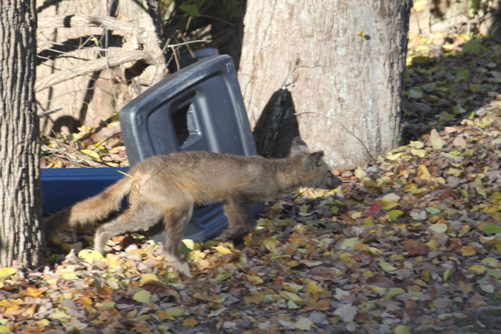
Observer: Megan Baker
Observation Date: 4/15/20
Observation Time: 3:45 p.m.
Observation Location: 15 Briggs Pond Way
Common Name: Gray Fox
Scientific Name: Urocyon cinereoargenteus
Comments: Spotted trotting across the back yard.
The gray fox has rounded ears, a dark-tipped tail and hooked claws. Unlike a red fox, the gray fox can climb, and will occasionally forage for food or rest in a tree. The gray fox’s ability to climb trees is shared only with the Asian raccoon dog among canids.
More Information: Wikipedia
Observer: Paul Lauenstein
Observation Date: 5/12/12
Observation Time: 8:30 a.m.
Observation Location: 5 Gavins Pond Rd.
Common Name: Gray Fox
Scientific Name: Urocyon cinereoargenteus
Comments: This species and the closely related Channel Island fox (Urocyon littoralis) are the only living members of the genus Urocyon, which is considered to be among the most primitive of the living canids. The gray fox’s ability to climb trees is shared only with the Asian raccoon dog among canids.
Though it was once the most common fox in the east, and still is found there, human advancement allowed the adaptable red fox to become more prevalent.
Note the dark stripe down the top of its tail. Gray foxes do not have a white-tipped tail like red foxes.
More Information: Wikipedia
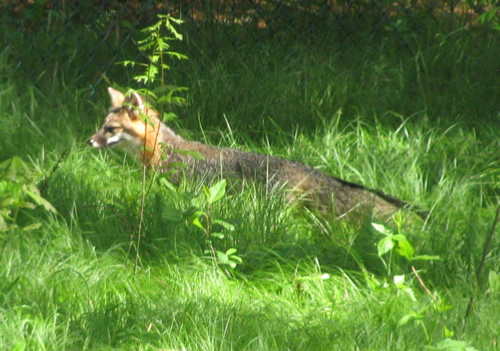
Observer: Josh Simons
Observation Date: 5/7/24
Observation Time: 1:00 p.m.
Observation Location: Moose Hill Parkway
Common Name: Gray Fox
Scientific Name: Urocyon cinereoargenteus
Comments: One of two passing through the yard…
The gray fox has rounded ears, a dark-tipped tail and hooked claws. Unlike a red fox, the gray fox can climb, and will occasionally forage for food or rest in a tree. The gray fox’s ability to climb trees is shared only with the Asian raccoon dog among canids.
More Information: Wikipedia
Observer: Paul Lauenstein
Observation Date: 7/24/10
Observation Time: 8:20 p.m.
Observation Location: 4 Gavins Pond Road
Common Name: Gray Fox
Scientific Name: Urocyon cinereoargenteus
Comments: I saw a small, gray-colored fox with a huge bushy tail at dusk (no photo opportunity).
More Information: Wikipedia
Observer: Paul Lauenstein
Observation Date: 4/4/11
Observation Time: 1:15 p.m.
Observation Location: 4 Gavins Pond Road
Common Name: Groundhog
Scientific Name: Marmota monax
Comments: This individual probably just emerged from hibernation.
More Information: Mass Audubon Society

Observer: John Wraga
Observation Date: 3/2/14
Observation Time: 2:45 p.m.
Observation Location: Traphole Brook at High Plain St.
Common Name: Mink
Scientific Name: Neovison vison
Comments: Mink are semi-aquatic. They eat crayfish, small frogs and fish, along with small mammals such as shrews, rabbits, mice, and muskrats. They also prey on ducks and other water fowl.
This mink was hit and killed by a vehicle as it crossed the road by Traphole Brook.
More Information: Wikipedia

Observer: Faith Berkland
Observation Date: 4/20/24
Observation Time: 9:45 a.m.
Observation Location: 302 Mansfield St., Sharon
Common Name: Mink
Scientific Name: Neovison vison
Comments: Mink are semi-aquatic. They eat crayfish, small frogs and fish, along with small mammals such as shrews, rabbits, mice, and muskrats. They also prey on ducks and other water fowl.
The mink I saw ran across my back yard. I am surrounded by drainage brooks and natural waterways. Sorry, no photo.
More Information: Wikipedia
Observer: Paul Lauenstein
Observation Date: 6/8/13
Observation Time: 6:08 p.m.
Observation Location: Beaver Brook near tennis courts
Common Name: Muskrat
Scientific Name: Ondatra zibethicus
Comments: Muskrats are fairly common near water in Sharon. They are native to North America, and related to voles and lemmings, but they are in a different genus from true rats.
More Information: Wikipedia
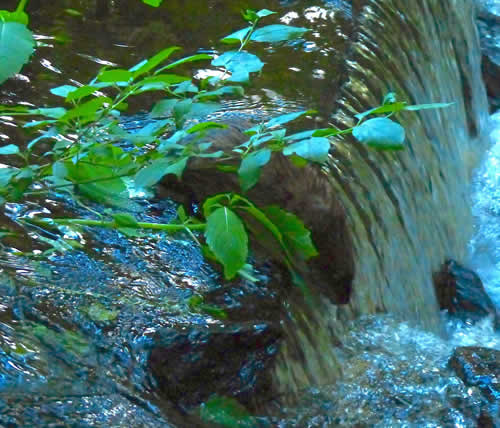
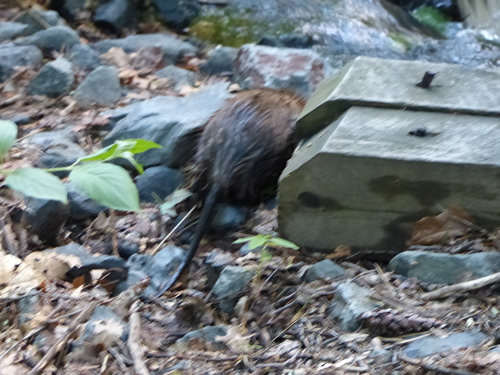
Observer: Paul Lauenstein
Observation Date: 9/30/12
Observation Time: 6:05 p.m.
Observation Location: Gavins Pond area
Common Name: Northern Short-tailed Shrew
Scientific Name: Blarina brevicauda
Comments: This venomous mammal is a highly active insectivore that consumes up to three times its weight daily. I don’t know why this specimen died.
More Information: Wikipedia
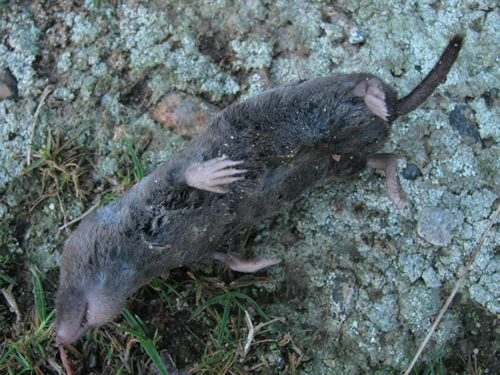
Observer: Richard Mandell
Observation Date: 10/12/10
Observation Time: dusk
Observation Location: Mountain St.
Common Name: Opossum
Scientific Name: Didelphimorphia
Comments: Opossums are voracious eaters that will try anything they find. Surprisingly, opossums eat ticks by the thousands. Ticks, particularly the black-legged ticks like deer ticks that are responsible for the spread of Lyme disease, appear to be a top item on the opossum’s menu. Several years ago, biologists put opossums and other species, like chipmunks, squirrels, mice, and catbirds to the test, giving each animal 100 ticks to eat. Opossums ate far more ticks than any other animal, leading scientists to estimate that just one opossum eats, on average, 5,000 ticks each year.
More Information: The National Opossum Society
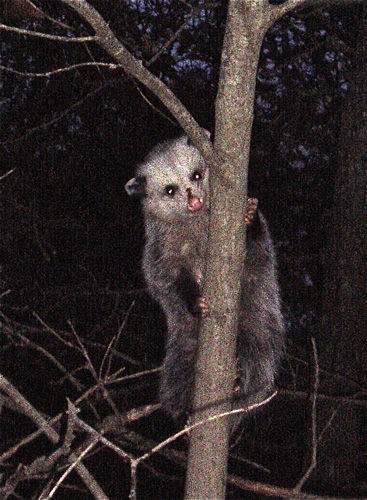
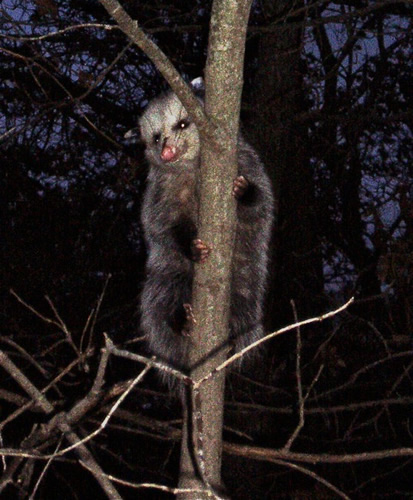
Observer: Rebecca Hickman
Observation Date: 7/17/12
Observation Time: n/a
Observation Location: Back yard
Common Name: Rabbit, Hawk, and Turkeys
Scientific Name: n/a
Comments: This past week, beginning last weekend, has been like watching an episode of National Geograhpic in my back yard. I’m exaggerating, but not by much..
I enjoy watching the little bunny that has taken up residency under our shed in our back yard.. I’m outside a lot, and I see him munching clover all the time.
Sunday morning I was outside having my morning cup of joe, and watching the bunny hop around on the freshly mowed lawn. Just then, what I’m assuming was a hawk came and snatched him. It happened so suddenly! At first I gasped and weakly yelled “no!” as the big bird of prey flew off with the fluffy guy. The area beyond our back yard is heavily wooded, and the trees are very tall so much of the aerial view is obscured by them and I didn’t see much more. I would have known it was a hawk with more certainty if I saw it flying more. My only good view of him was by the back of his wings when he came down, and took off. It was sad to see the bunny go, but mostly it was an amazing thing to see and I’m glad I got too see such a moment in person.
Then, yesterday I went outside to grill some hot dogs and there were two big turkeys in the yard. I grabbed my toddler and brought him out for a peek, but I knew to stay close to the safety of the door. I know from past experience that turkeys can be aggressive. The experience was when my curiousity brought me close to a pack of turkeys while I was driving in Scituate. The turkeys charged and gobble- gobbled and attacked the tires of our mini van. I was so startled that I told my husband to lock the doors. I started laughing at the silliness of my reaction, but when I saw that he actually DID lock his door, I laughed even more.
Observer: Rick Dumont
Observation Date: 5/21/09
Observation Time: 9:00 a.m.
Observation Location: Belcher St.
Common Name: Raccoon
Scientific Name: Procyon lotor
Comments: The raccoon is mostly nocturnal. It is also solitary, except for mothers and their young. In the winter the raccoon may sleep in its den for a few weeks but it does not hibernate. The raccoons usually walks, but it can run at speeds of up to 15 miles an hour. It is also a good swimmer and often hunts for food in the water. The raccoon makes a variety of vocalizations including hisses, whistles, screams, growls and snarls.
More Information: Nature Works

Observer: Josh Simons
Observation Date: 6/19/20
Observation Time: 3:30 p.m.
Observation Location: Moose Hill area
Common Name: Raccoon
Scientific Name: Procyon lotor
Comments: Raccoons are mainly nocturnal, but this family was out foraging during the day. Raccoons are smart and quite capable of defending themselves against dogs or anything else that might try to harass them.
More Information: National Geographic
Observer: Richard Mandell
Observation Date: 8/20/2016
Observation Time: 2:00 p.m.
Observation Location: Mountain Street
Common Name: Raccoon
Scientific Name: Procyon lotor
Comments: Unusual to see out during the day, as raccoons are mainly nocturnal. Probably looking for the bird feeders, which I now take in at night since raccoons plundered them at night. Check out the nighttime photo I took of a raccoon trying to get sugar water from our hummingbird feeder. It’s posted at this site.
More Information: National Geographic
Observer: Richard Mandell
Observation Date: 6/23/16
Observation Time: 2:04 a.m.
Observation Location: 580 Mountain Street (Back Deck)
Common Name: Raccoon
Scientific Name: Procyon lotor
Comments: This explains why the hummingbirds seemed so thirsty that the feeder was emptying every night.
More Information: Living with Wildlife
Observer: Kurt Buermann
Observation Date: 6/16/20
Observation Time: 8:20 p.m.
Observation Location: Furnace Street
Common Name: Raccoon and Gray Fox
Scientific Name: Procyon lotor and Urocyon cinereoargenteus
Comments: This raccoon and gray fox – both of which are predators – were feeding peacefully together on the porch.
More Information: Wikipedia and Nature Works
Here’s a link to the video: https://www.youtube.com/watch?v=BX-v4iZD_j4
Observer: Alison Siegel
Observation Date: 1/5/10
Observation Time: 6:00 a.m.
Observation Location: Lakeview St.
Common Name: Red Fox
Scientific Name: Vulpes vulpes
Comments: A fox was spotted running on the frozen lake early in the morning.
More Information: Animal Diversity Web
Observer: Paul Lauenstein
Observation Date: 10/16/12
Observation Time: 8:55 a.m.
Observation Location: 4 Gavins Pond Road (back yard)
Common Name: Red Fox
Scientific Name: Vulpes vulpes
Comments: This red fox showed up in our back yard. I took these photos out the window. Apart from its large size, the red fox is distinguished from other fox species by its ability to adapt quickly to new environments and, unlike most of its related species, is not listed as endangered anywhere.
More Information: Animal Diversity Web
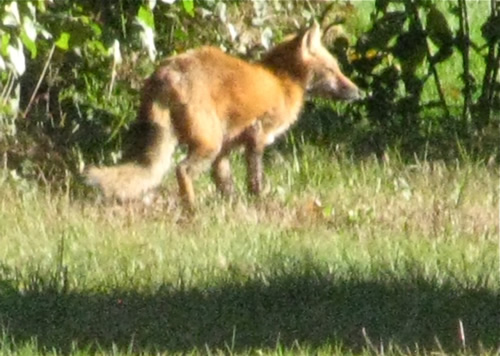
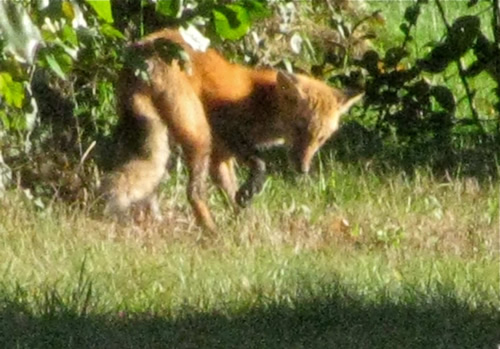
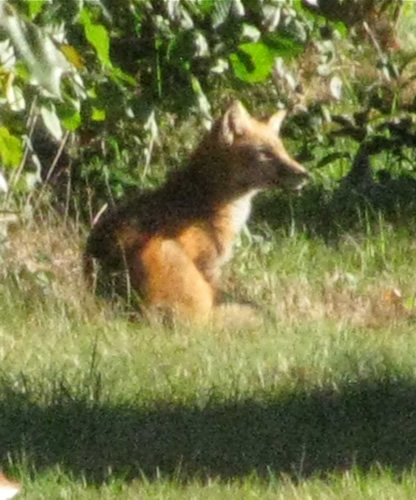
Observer: Deborah Radovsky
Observation Date: 11/30/21
Observation time: 3:45 a.m.
Observation Location: Rock Ridge Cemetery
Common Name: Red fox
Scientific Name: Vulpes vulpes
Comments: Red foxes and gray foxes have both been sighted in Sharon. They are only distant cousins, belonging to different genera in the family Canidae. Gray foxes can climb trees but red foxes cannot.
More Information: National Wildlife Federation
Observer: Alison Siegel
Observation Date: 3/3/10
Observation Time: 7:30 a.m.
Observation Location: Lakeview St.
Common Name: Red Fox
Scientific Name: Vulpes vulpes
Comments: My sons and I were finishing breakfast and saw a fox walk across our backyard, close to Lake Massapoag.
More Information: Animal Diversity Web
Observer: Alison Siegel
Observation Date: 4/13/10
Observation Time: 6:00 a.m.
Observation Location: backyard
Common Name: Red Fox
Scientific Name: Vulpes vulpes
Comments: Fox was spotted walking across our backyard, close to Lake Massapoag.
More Information: Animal Diversity Web
Observer: Faith Berkland
Observation Date: 4/14/18
Observation time: not reported
Observation Location: 302 Mansfield Street, Sharon, MA
Common Name: Red fox
Scientific Name: Vulpes vulpes
More information: National Wildlife Foundation
Observer: Alison Siegel
Observation Date: 4/17/10
Observation Time: 9:30 a.m.
Observation Location: Lake Massapoag and Lakeview St
Common Name: Red Fox
Scientific Name: Vulpes vulpes
Comments: A fox was spotted walking from the Massapoag Yacht Club into our backyard. It proceeded across our back lawn to our neighbor’s yard, and then it returned to our sideyard, walked up our front driveway toward Lakeview St, eventually returning in the direction of the boat club.
More Information: Animal Diversity Web
Observer: Paul Lauenstein
Observation Date: 6/25/20
Observation time: 8:45 a.m.
Observation Location: 4 Gavins Pond Rd.
Common Name: Red fox
Scientific Name: Vulpes vulpes
Comments: It was a thrill to see these three playful red foxes in our back yard. One of them seemed quite interested in the neighbor’s fluffy cat, which stood its ground.
Despite its name, individual red foxes have variable coloration. The red fox’s bushy tail has a white tip. The gray fox(Urocyon cinereoargenteus) is a different species. Its tail does not have a white tip. Gray foxes can climb trees. Red foxes cannot.
The red fox originated from smaller ancestors in Eurasia and colonised North America shortly after the Wisconsin glaciation, which ended about 11,000 years ago. Apart from its relatively large size, the red fox is distinguished from other fox species by its ability to adapt quickly to new environments.
More Information: Wikipedia
Observer: Andrea & Herb Daroff
Observation Date: 7/4/10
Observation Time: 5:00 p.m.
Observation Location: Pilgrim Drive
Common Name: Red Fox
Scientific Name: Vulpes vulpes
Comments: The fox was within 10 feet of our house. It spent a good 10 minutes sniffing around (looking for bugs maybe?) This was not the first time we have seen a fox in our yard but this is the first time we have seen it hanging around so close to the house and for long enough for us to be able to grab a camera. Unfortunately, we had to photograph through a window screen so the picture isn’t as sharp as it should be.
More Information: Animal Diversity Web
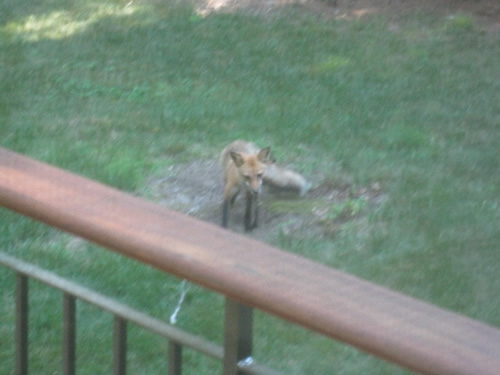
Observer: Ilan Fisher
Observation Date: 2005
Observation Location: Back yard
Common Name: Red Foxes
Scientific Name: Vulpes vulpes
Comments: My wife saw the mom walking in our back yard. A few days later, I saw one of the babies standing beside my swimming pool. I thought it was a strange looking cat; and then I thought, dog; and then I thought, fox. He scooted under the stockade fence. I climbed up and saw that it was living under my neighbor’s shed. I tried to get a photograph but it was too far away for any lens I had.
In the end, I set up a ladder, sat on top – checked on and off for a few days – with my video camera; and then I saw them. I had to use digital zoom to get these shots, that’s why there is so much camera shake. That was the last I saw of them. I suppose the mother moved them every few days. And what’s that they were eating? Well, not my cat – probably somebody’s.
Youtube video: UpTown Foxes – Sharon, MA
Observer: Ellenor Yahrmarkt
Observation Date: 5/11/09
Observation Location: Borderland State Park
Common Name: Red Fox
Scientific Name: Vulpes vulpes
Comments: Fox kits in a den under a foundation
More Information: Wikipedia: Red Fox & National Geographic
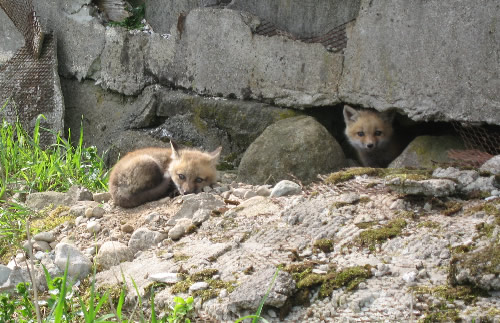
Observer: Josh Simons
Observation Date: 11/28/08
Observation Time: 10:00 a.m.
Observation Location: Moose Hill Parkway
Common Name: Red Squirrel
Scientific Name: Tamiasciurus hudsonicus
Comments: The red squirrel is known to “tap” maple trees. It bites the bark until sap flows out, and returns later for a sweet treat after the water in the sap has evaporated.
More Information: http://www.nhptv.org/Natureworks/Redsquirrel.htm
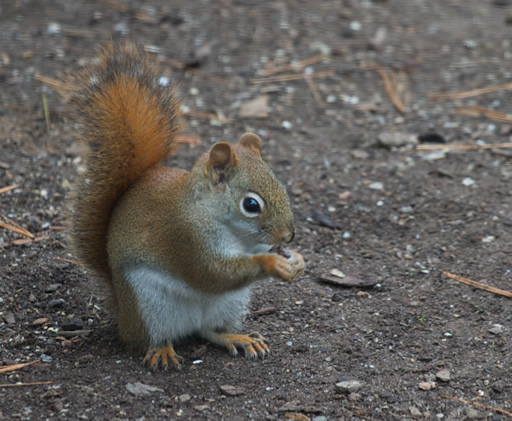
Observer: Josh Simons
Observation Date: 3/9/11
Observation Time: 8:00 a.m.
Observation Location: Moose Hill area
Common Name: Red Squirrel
Scientific Name: Tamiasciurus hudsonicus
More Information: http://www.nhptv.org/Natureworks/Redsquirrel.htm
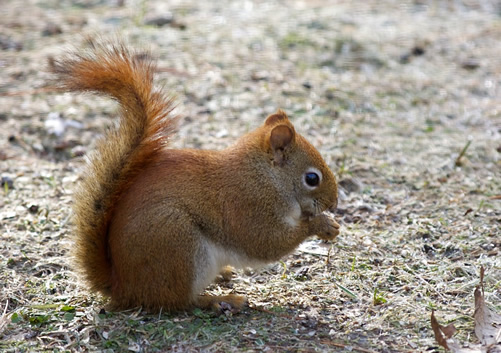
Observer: Paul Lauenstein
Observation Date: 4/21/24
Observation Time: 10 a.m.
Observation Location: Moose Hill Audubon Wildlife Sanctuary
Common Name: Red Squirrel
Scientific Name: Tamiasciurus hudsonicus
Comments: Red squirrels can be easily distinguished from other North American tree squirrels by their smaller size, territorial behavior, and reddish fur with a white underbelly. Red squirrels are somewhat larger than chipmunks and lack chipmunks’ distinctive stripes.
More Information: Wikipedia
Observer: Paul Lauenstein
Observation Date: 4/25/24
Observation Time: 9:00 a.m.
Observation Location: Moose Hill Audubon Wildlife Sanctuary
Common Name: Red Squirrel
Scientific Name: Tamiasciurus hudsonicus
Comments: I encountered this red squirrel perched on a branch just a few feet from the boardwalk through the wetland at Moose Hill Audubon Wildlife Sanctuary. It was surprisingly unafraid of me, and posed while I took these photos.
Red squirrels can be easily distinguished from other North American tree squirrels by their smaller size, territorial behavior, and reddish fur with a white underbelly. Red squirrels are somewhat larger than chipmunks and lack chipmunks’ distinctive stripes.
More Information: Wikipedia
Observer: Paul Lauenstein
Observation Date: 4/26/13
Observation Time: 4:20 p.m.
Observation Location: Moose Hill Audubon Wildlife Sanctuary
Common Name: Red Squirrel
Scientific Name: Tamiasciurus hudsonicus
Comments: American red squirrels experience severe early mortality (on average only 22% survive to one year of age). The survival probability, however, increases to age three, when it begins to decrease again. Females that survive to one year of age have a life expectancy of 2.3 years and a maximum lifespan of eight years.
More Information: Wikipedia
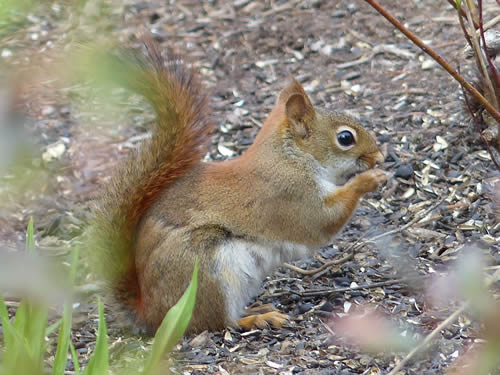
Observer: Paul Lauenstein
Observation Date: 5/12/23
Observation Time: 6:00 a.m.
Observation Location: Moose Hill Audubon Wildlife Sanctuary
Common Name: Red Squirrel
Scientific Name: Tamiasciurus hudsonicus
Comments: Red squirrels can be easily distinguished from other North American tree squirrels by their smaller size, territorial behavior, and reddish fur with a white underbelly. Red squirrels are somewhat larger than chipmunks.
More Information: Wikipedia
Observer: Paul Lauenstein
Observation Date: 5/12/25
Observation Time: 7:15 a.m.
Observation Location: Moose Hill Audubon Wildlife Sanctuary
Common Name: Red Squirrel
Scientific Name: Tamiasciurus hudsonicus
Comments: Red squirrels can be easily distinguished from other North American tree squirrels by their smaller size, territorial behavior, and reddish fur with a white underbelly. Red squirrels are somewhat larger than chipmunks and lack chipmunks’ distinctive stripes.
More Information: Wikipedia
Observer: Paul Lauenstein
Observation Date: 5/8/19
Observation Time: 7:50 a.m.
Observation Location: Moose Hill Audubon Wildlife Sanctuary
Common Name: Red Squirrel
Scientific Name: Tamiasciurus hudsonicus
Comments: Red squirrels can be easily distinguished from other North American tree squirrels by their smaller size, territorial behavior, and reddish fur with a white underbelly). Red squirrels are somewhat larger than chipmunks.
More Information: Wikipedia
Observer: Paul Lauenstein
Observation Date: 6/22/23
Observation Time: 11:15 a.m.
Observation Location: Moose Hill Audubon Wildlife Sanctuary
Common Name: Red Squirrel
Scientific Name: Tamiasciurus hudsonicus
Comments: Red squirrels can be easily distinguished from other North American tree squirrels by their smaller size, territorial behavior, and reddish fur with a white underbelly. Red squirrels are somewhat larger than chipmunks and lack chipmunks’ distinctive stripes.
Red squirrels are territorial. This one was being chased away by another one.
More Information: Wikipedia

